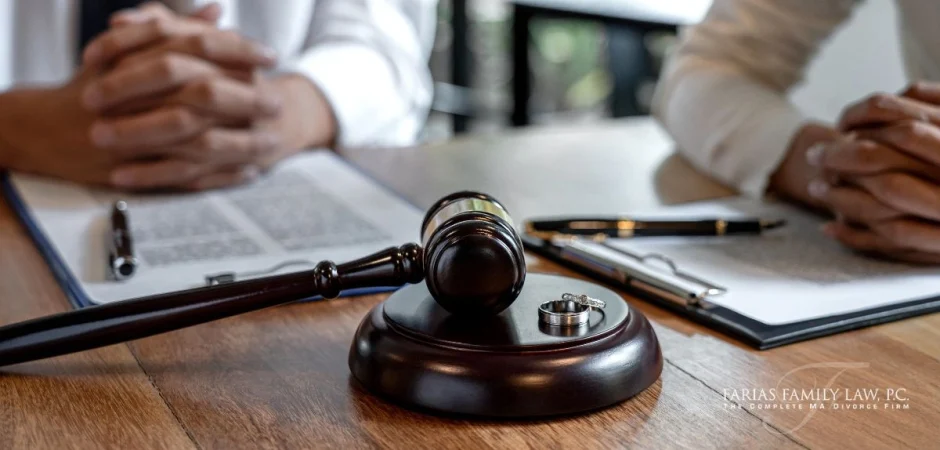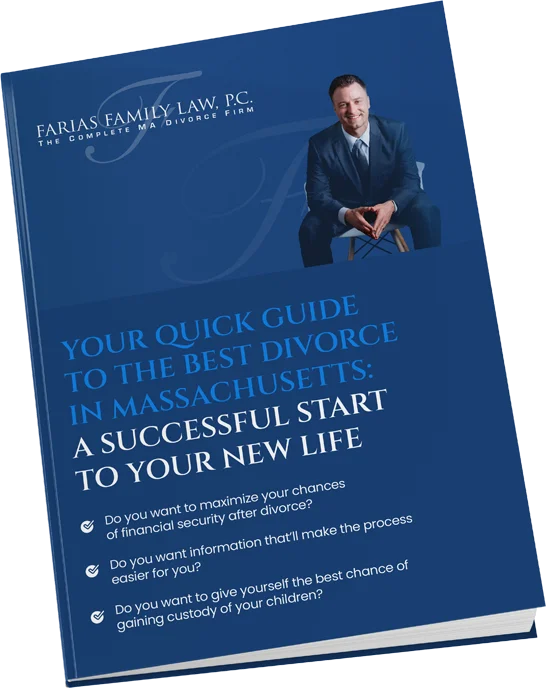Massachusetts Divorce Process

Divorces can be highly emotional and fraught with uncertainty, especially as laws and procedures evolve over time. Whether you’re seeking an uncontested divorce or facing a contested case, understanding the steps involved is essential to achieving a fair resolution. The Massachusetts divorce process reflects a commitment to clarity and efficiency, with updates to enable families to move forward effectively.
For a contested divorce, a complaint is filed, and the other party is then served usually by a constable with a copy of the complaint and a summons. And the process officially begins.
Next, a case management conference is scheduled. That’s the time at which the court establishes deadlines by which information (usually financial) will be exchanged. The exchange of information is known in the legal world as “discovery.”
If there are issues that require the immediate attention of the court, a motion for temporary orders can be filed by either party. At that hearing, issues such as child custody, visitation, support, whether alimony should be paid and how much, who’s responsible for the bills, and other similar issues are addressed. The resulting order remains in effect until either it’s changed or incorporated into a final agreement.
Divorce Example 1:
David, the breadwinner, leaves his wife, Janice, and their children at home, and moves in with his new girlfriend. Janice must file a motion for temporary orders – usually together with a complaint about divorce – to put child support in place as soon as possible.
Divorce Example 2:
Ted and Tina decide to live separately while their divorce is pending. Tina is upset that Ted is seeing another woman, so she will not allow him to see the children. Ted must immediately file a motion for temporary orders to address the issue.
The next step is a pretrial conference hearing. At that stage, the judge expects the attorneys and parties to continue to try to resolve the case. If there are outstanding issues, the judge may weigh in on them and attempt to guide the parties to a resolution – or at least narrow the issues. If the case is still not resolved at a pretrial conference hearing, it’s usually scheduled for trial.
The trial is the event at which the judge hears and examines evidence on the case: witness testimony, including the parties, documentary evidence, including the parties’ financial statements and records, business records, expert testimony, etc. At the conclusion, the judge rules on the contested issues.
It’s important to understand that if the parties come to an agreement at any point during a contested divorce, the divorce then becomes uncontested, an agreement is signed, and the parties can be divorced relatively quickly.
An uncontested divorce, on the other hand, may only be filed if the parties are in agreement on all of the issues at the outset. The divorce agreement is signed and filed along with some other necessary documents, and an uncontested divorce hearing is scheduled. At that hearing, the judge usually approves the divorce. The main drawback of proceeding uncontested from the beginning is that it creates an opportunity for one of the parties to stall indefinitely because the case is not in court.
Divorce Example 3:
Wendy wants a divorce as soon as possible. Husband tells her that he wants to work things out before filing. Weeks and months come and go and he’s dragging his feet, and there’s nothing preventing him from dragging his feet further. If the wife had filed initially, there would be regularly scheduled court events, which may have put pressure on the husband to resolve the case or risk having it scheduled for trial.
For uncontested divorces, mediation is a useful tool for parties that believe they can come to an agreement but want some input from a neutral third-party. For higher-quality mediation, the parties must hire someone – usually an experienced attorney – to hear both sides and make a recommendation. If the parties agree, they may file uncontested. It’s recommended that you retain a Massachusetts divorce attorney to advise you during the mediation process – a mediator is not looking out for your best interest, but your own attorney will.
Tip:
A contested divorce becomes uncontested when parties reach an agreement on all issues. So if you’re close to an agreement and want the case resolved sooner rather than later, but think your spouse will delay, you may file a contested to move the process along, then change it to uncontested when you have an agreement.
Filing for Divorce in Massachusetts
The first step in the Massachusetts divorce process requires filing the appropriate paperwork. Couples can file for a no-fault divorce, citing an irretrievable breakdown of the marriage, or a fault-based divorce that requires specific grounds, such as abuse or adultery. Filing requires completing a complaint for divorce or submitting it to the family court that has jurisdiction over your case.
Along with the complaint, parties must provide financial statements, supply any applicable child-related documents, and pay the filing fee. Proper filings enable the legal process to begin smoothly and without delay.
Setting Temporary Orders
Temporary orders establish stability while the divorce is ongoing. These orders can address critical issues such as child custody, child support, spousal support, and living arrangements. Either party can request temporary orders, which are designed to ensure fairness and prevent disruption to the lives of children and other family members.
An attorney can prepare for the temporary order hearing by first learning about your goals and needs. Your lawyer can make sure the court has the necessary evidence to rule in your favor. Temporary orders remain in effect until the divorce is finalized or modified by the court.
Discovery and Financial Disclosures
The discovery phase is a crucial part of the Massachusetts divorce process, especially when property division, alimony, or child support are at stake. Both parties must provide detailed financial disclosures, including income, expenses, assets, and debts.
Discovery tools, such as interrogatories, subpoenas, and depositions, may be used to gather additional information. Transparency during this phase is critical. Failing to disclose assets or income can lead to legal penalties or unfavorable outcomes. If your soon-to-be ex might be concealing assets, let your attorney know so the matter can be investigated.
Negotiation and Mediation
Many divorces in Massachusetts are resolved through negotiation or mediation, avoiding the need for a trial. During this stage, both parties work to reach agreements on key issues, such as property division, alimony, and child custody. Mediation, facilitated by a neutral third party, can provide a less adversarial approach to resolving disputes.
An experienced divorce attorney protects your interests during negotiations by crafting fair and enforceable agreements. If mediation or negotiation fails, the case may proceed to court.
Finalizing the Divorce
Once all issues have been resolved, either through an agreement or a court ruling, the divorce process moves toward finalization. The court reviews the proposed agreements or judgments to ensure compliance with Massachusetts law and fairness to both parties.
For uncontested divorces, finalization is typically quicker and usually involves a short court hearing. Contested divorces may require additional steps, including trial and judge-issued decisions. Once the divorce decree is signed, both parties are legally divorced and bound by the terms of the decree.
Updates to the Massachusetts Divorce Process
Massachusetts family law continues to evolve to reflect modern families’ needs and ensure equitable outcomes. A key update is the enactment of the Massachusetts Parentage Act, a historic measure that modernizes parentage laws for the first time in decades.
This legislation emphasizes inclusivity, providing legal recognition and protections for families formed through surrogacy, in-vitro fertilization, and assisted reproduction. It also addresses the needs of LGBTQ+ families so all parents, regardless of marital status or gender identity, have equal rights.
The Parentage Act updates outdated terminology, replacing terms like “paternity” with “parentage” to reflect a broader understanding of family structures.
FAQs
Q: How Long Does It Take to Get Divorced in Massachusetts?
A: The time to finalize a divorce in Massachusetts depends on the type of divorce and the court’s schedule. Uncontested divorces may take a few months, while contested divorces can take a year or longer. Factors such as disputes over property, custody, and support affect the timeline. A streamlined process is possible when both parties agree on all terms and promptly submit the necessary paperwork.
Q: What Is a Wife Entitled to in a Divorce in Massachusetts?
A: In a Massachusetts divorce, a wife may be entitled to an equitable share of marital property, spousal support, and, if applicable, child custody and support. The court considers factors like the length of the marriage, financial contributions, and future needs when dividing assets or awarding support. Massachusetts law focuses on fairness rather than an automatic equal division of assets.
Q: Is Massachusetts a 50/50 State for Divorce?
A: Massachusetts is not strictly a 50/50 state for property division in divorce. Instead, the state follows equitable distribution, meaning assets are divided based on fairness rather than equally. Courts consider factors such as the length of the marriage, each spouse’s financial situation, and their contributions to the marriage to determine a fair division of property.
Q: What Is the Fastest Way to Get a Divorce in Massachusetts?
A: The fastest way to get a divorce in Massachusetts is through an uncontested divorce. This requires both parties to agree on all issues, including property division, spousal support, and child custody if applicable. Filing a joint petition and submitting a separation agreement can expedite the process. Timely paperwork and cooperation from both spouses are essential for a quicker resolution.
Schedule Your Family Law Assessment Today
Divorce is a life-changing event that requires careful planning and informed decision-making. Whether you are just beginning the process or need assistance in navigating complex legal issues, taking the right steps now can protect your rights and ensure a fair outcome.
From property division to child custody arrangements, every aspect of divorce deserves skilled guidance, tailored to your unique circumstances. We can provide compassionate and strategic representation to help you confidently navigate this challenging time. Contact Farias Family Law, P.C., to schedule your divorce assessment today.

Your Quick Guide To The Best Divorce In Massachusetts
Download A Free Copy Of Our EBook, “Your Quick Guide To The Best Divorce In Massachusetts: A Successful Start To
Your New Life” By Clicking On The Link Below.

